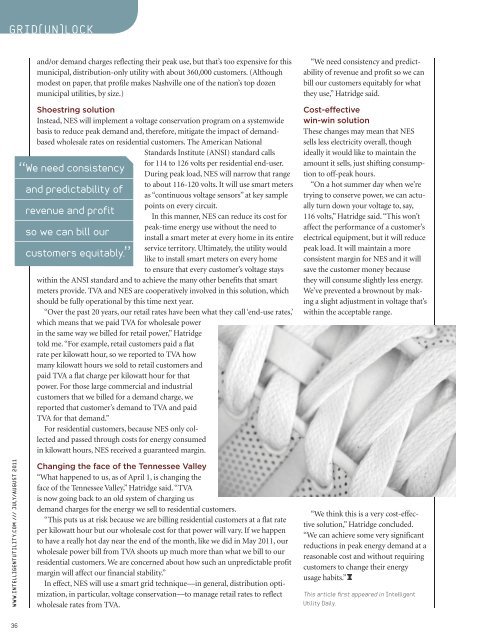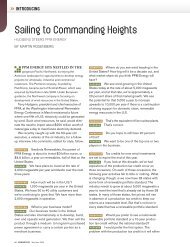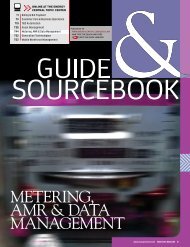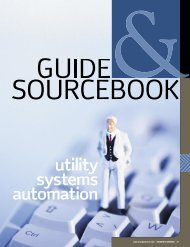FERC vs NERC: A grid control showdown over cyber security
FERC vs NERC: A grid control showdown over cyber security
FERC vs NERC: A grid control showdown over cyber security
Create successful ePaper yourself
Turn your PDF publications into a flip-book with our unique Google optimized e-Paper software.
GRID(UN)LOCK<br />
WWW.INTELLIGENTUTILITY.COM /// JULY/AUGUST 2011<br />
36<br />
“<br />
and/or demand charges reflecting their peak use, but that’s too expensive for this<br />
municipal, distribution-only utility with about 360,000 customers. (Although<br />
modest on paper, that profile makes Nashville one of the nation’s top dozen<br />
municipal utilities, by size.)<br />
Shoestring solution<br />
Instead, NES will implement a voltage conservation program on a systemwide<br />
basis to reduce peak demand and, therefore, mitigate the impact of demandbased<br />
wholesale rates on residential customers. The American National<br />
Standards Institute (ANSI) standard calls<br />
for 114 to 126 volts per residential end-user.<br />
We need consistency<br />
During peak load, NES will narrow that range<br />
to about 116-120 volts. It will use smart meters<br />
and predictability of<br />
as “continuous voltage sensors” at key sample<br />
points on every circuit.<br />
revenue and profit<br />
In this manner, NES can reduce its cost for<br />
peak-time energy use without the need to<br />
so we can bill our<br />
install a smart meter at every home in its entire<br />
service territory. Ultimately, the utility would<br />
customers equitably. ”<br />
like to install smart meters on every home<br />
to ensure that every customer’s voltage stays<br />
within the ANSI standard and to achieve the many other benefits that smart<br />
meters provide. TVA and NES are cooperatively involved in this solution, which<br />
should be fully operational by this time next year.<br />
“Over the past 20 years, our retail rates have been what they call ‘end-use rates,’<br />
which means that we paid TVA for wholesale power<br />
in the same way we billed for retail power,” Hatridge<br />
told me. “For example, retail customers paid a flat<br />
rate per kilowatt hour, so we reported to TVA how<br />
many kilowatt hours we sold to retail customers and<br />
paid TVA a flat charge per kilowatt hour for that<br />
power. For those large commercial and industrial<br />
customers that we billed for a demand charge, we<br />
reported that customer’s demand to TVA and paid<br />
TVA for that demand.”<br />
For residential customers, because NES only collected<br />
and passed through costs for energy consumed<br />
in kilowatt hours, NES received a guaranteed margin.<br />
Changing the face of the Tennessee Valley<br />
“What happened to us, as of April 1, is changing the<br />
face of the Tennessee Valley,” Hatridge said. “TVA<br />
is now going back to an old system of charging us<br />
demand charges for the energy we sell to residential customers.<br />
“This puts us at risk because we are billing residential customers at a flat rate<br />
per kilowatt hour but our wholesale cost for that power will vary. If we happen<br />
to have a really hot day near the end of the month, like we did in May 2011, our<br />
wholesale power bill from TVA shoots up much more than what we bill to our<br />
residential customers. We are concerned about how such an unpredictable profit<br />
margin will affect our financial stability.”<br />
In effect, NES will use a smart <strong>grid</strong> technique—in general, distribution optimization,<br />
in particular, voltage conservation—to manage retail rates to reflect<br />
wholesale rates from TVA.<br />
“We need consistency and predictability<br />
of revenue and profit so we can<br />
bill our customers equitably for what<br />
they use,” Hatridge said.<br />
Cost-effective<br />
win-win solution<br />
These changes may mean that NES<br />
sells less electricity <strong>over</strong>all, though<br />
ideally it would like to maintain the<br />
amount it sells, just shifting consumption<br />
to off-peak hours.<br />
“On a hot summer day when we’re<br />
trying to conserve power, we can actually<br />
turn down your voltage to, say,<br />
116 volts,” Hatridge said. “This won’t<br />
affect the performance of a customer’s<br />
electrical equipment, but it will reduce<br />
peak load. It will maintain a more<br />
consistent margin for NES and it will<br />
save the customer money because<br />
they will consume slightly less energy.<br />
We’ve prevented a brownout by making<br />
a slight adjustment in voltage that’s<br />
within the acceptable range.<br />
“We think this is a very cost-effective<br />
solution,” Hatridge concluded.<br />
“We can achieve some very significant<br />
reductions in peak energy demand at a<br />
reasonable cost and without requiring<br />
customers to change their energy<br />
usage habits.”<br />
This article first appeared in Intelligent<br />
Utility Daily.















![View From the Trenches [PDF]](https://img.yumpu.com/18854438/1/190x252/view-from-the-trenches-pdf.jpg?quality=85)
